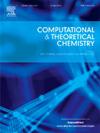n -苯甲酰- n′-苯基硫脲衍生物热分解动力学及机理的DFT研究
IF 3
3区 化学
Q3 CHEMISTRY, PHYSICAL
引用次数: 0
摘要
本文对N′-苯基环上有取代基的N-苯甲酰-N′-苯基硫脲(BPT)的5个衍生物的气相消去机理进行了理论研究。利用反应力和电子通量对反应曲线(能量与反应坐标)进行了评价。我们用CHELPG电荷研究了电子密度分布。利用Mayer键序和固有键强度指数(IBSI)分析了键断裂和键形成。在B3LYP-GD3/Def2TZVPP理论水平上,使用高斯16软件,使用密度泛函理论(DFT)进行计算。结果表明,N ' -苯基上的强吸电子取代基稳定了初始态,提高了激活势垒。适度的吸电子效应,如3-氯和4-氯苯基,促进了更有效的电子重组,导致过渡态,降低了激活能。这些发现为预测类似体系的反应性和优化具有特定性质的新化合物的设计提供了定量框架。本文章由计算机程序翻译,如有差异,请以英文原文为准。

DFT study in the kinetics and mechanism of the thermal decomposition of N-benzoyl-N′-phenylthiourea derivatives
This work presents a theoretical study on the mechanism of the gas phase elimination of five derivatives of N-benzoyl-N′-phenylthiourea (BPT), with substituents at the N′-phenyl ring. The reaction profiles, energy vs. reaction coordinate, were evaluated using the force of reaction and electronic flux. We investigated the electron density distribution employing CHELPG charges. Bond breaking and bond formation were analyzed using Mayer's bond order and intrinsic bond strength index (IBSI) calculations. Calculations were performed using Density Functional Theory (DFT), with Gaussian 16 software, at the B3LYP-GD3/Def2TZVPP level of theory. The results suggest that strong electron-withdrawing substituents at the N′-phenyl stabilize the initial state and raise the activation barrier. Moderate electron-withdrawing effects, e.g., 3-chloro and 4-chlorophenyl, promote a more efficient electronic reorganization leading to the transition state, lowering the energy of activation. These findings provide a quantitative framework to predict the reactivity of similar systems and optimize the design of novel compounds with specific properties.
求助全文
通过发布文献求助,成功后即可免费获取论文全文。
去求助
来源期刊

Computational and Theoretical Chemistry
CHEMISTRY, PHYSICAL-
CiteScore
4.20
自引率
10.70%
发文量
331
审稿时长
31 days
期刊介绍:
Computational and Theoretical Chemistry publishes high quality, original reports of significance in computational and theoretical chemistry including those that deal with problems of structure, properties, energetics, weak interactions, reaction mechanisms, catalysis, and reaction rates involving atoms, molecules, clusters, surfaces, and bulk matter.
 求助内容:
求助内容: 应助结果提醒方式:
应助结果提醒方式:


